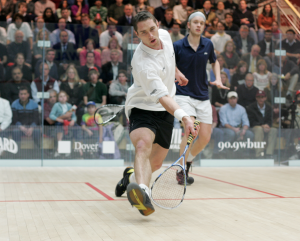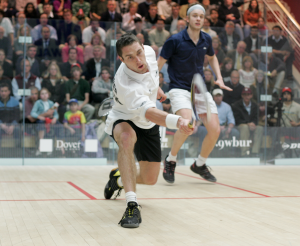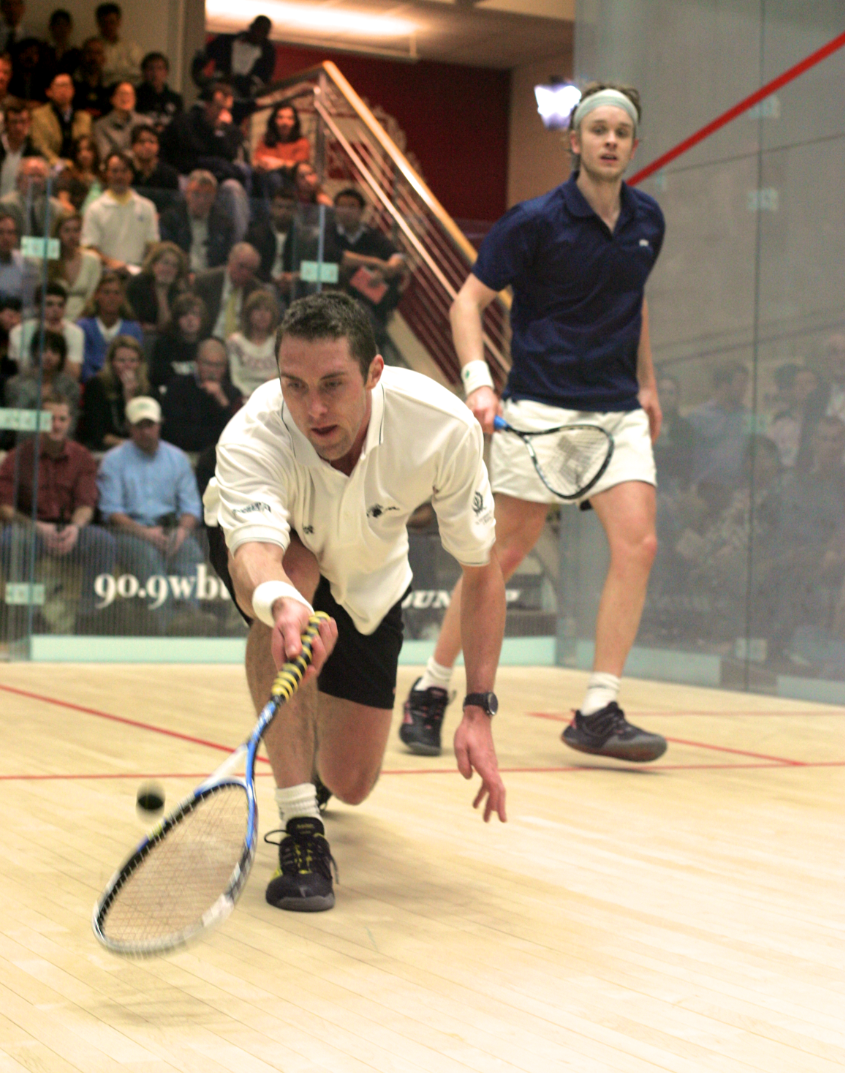By Richard Millman, Director of Squash, Kiawah Island Club
Let me first qualify my title this month by saying that the words “who says there’s no spin in Squash?’”—should read “who says there’s no spin in Softball Squash?”—as there are many fine shots and skills in the world of top class Hardball—just one of the fascinating variations that divide our two wonderful versions of the Squash game.
Last month I talked about the mechanics of the “float”—one of the key shots in modern softball Squash in my opinion. Just as the mechanics of the ‘float’ are definable and attainable, the same is true of the drop shot.
Let us first break down what we mean by a drop shot. In this discussion a drop shot is any shot that is played short to the front of the court, that strikes the front wall before hitting either the side wall or the floor.
Typically, this shot is introduced to novice players by feeding a gentle ball to the front of the court and having the player strike the ball into the front corner on the same side as the feed. This would be a straight drop as opposed to the same shot played across the court in to the opposite front corner which would be a cross (court) drop.

To become adept at this skill it is important not only to learn the mechanics of this simple version of the shot, but also of the several advanced progressions of the shot that an advanced player needs to have at their disposal.
First let’s look at the mechanics of a basic drop shot:
Remember that the size of the swing of any given shot is dependent on how much time you either have available or want to use. Therefore the stroke size of a drop shot will typically be smaller if you are under pressure and larger if you are not.
Most coaches feed a nice easy ball that affords plenty of time to execute the shot and so a full preparation is possible. As with all softball shots, the follow-through should be slightly lengthier than the preparation and swing prior to contact. The ball should be struck on the upper part of the racquet face (not the so-called sweet spot) which responds to the fingers more than the palm of the hand.
The less time that is available, the less overall swing should be used—but still taking care to insure that there is always proportionately more swing after contact than before—a ratio of 40% before to 60% after the contact is a good guide line, although up to 75% may be used.
As with all softball Squash shots, energy is supplied from the legs, shifting the weight rhythmically up the body until the energy wave travels down and through the limber muscles of a relaxed but controlled arm, through the hand and fingers, along the shaft of the racquet, and finally through the specific two pairs of strings (a pair of cross strings and a pair of main strings) that intersect and propel the ball. It is necessary to specifically visualize the exact point of contact and intimately know it, just as you might have intimate knowledge of the nib of your pen or pencil.
The whole shot is an exercise in movement with the rhythm that supplies weight and delicate power to the ball being procured by the whiplash effect of moving your body back (into position for the next shot) at the same moment as you allow your racquet to move forward—just as the end of a wet towel will create more pain in your unfortunate victim if you step back at the instant you flick it, rather than standing still.
 Remember softball Squash is a game of movement. Being static as you hit the ball produces tension in the arm which in turn prevents the sensitivity required for fine control. Imagine a darts player (the consummate finesse sportsman) attempting to retain precision while trying to support a 50 pound weight on his throwing arm! The stress of the weight bearing would all but make the fine control required for hitting the target impossible.
Remember softball Squash is a game of movement. Being static as you hit the ball produces tension in the arm which in turn prevents the sensitivity required for fine control. Imagine a darts player (the consummate finesse sportsman) attempting to retain precision while trying to support a 50 pound weight on his throwing arm! The stress of the weight bearing would all but make the fine control required for hitting the target impossible.
Take stress on the musculature designed for stress (the legs) and leave precision to the limbs that are engineered for precision (arms, hands and fingers).
Once you have learned the mechanics of a basic drop it is important to move on progressively to more difficult situations.
The next step is to deal with a situation in which you have options but less time. Instead of the coach providing you a nice juicy feed, perhaps you are in a drill where the ball doesn’t sit up for as long. Less time? That’s right—less swing. And also less activity in the execution of the shot.
Perhaps when you first learned the drop shot you sliced or cut the ball down to improve your directional control? Think for a moment—is this something you do with your drop shot—slice it? As the degree of difficulty increases, the total number of movements/components must be decreased.
For instance if you are striking a ball that is either at or below the level of the tin, you must not slice the ball. There isn’t enough time/space to fit all that activity in. Intstead lift the ball with a clean (not sliced) contact and focus on keeping the ball tight (close to the side wall).
The next step is dealing with a ball that not only affords you less time, but also less space. Perhaps in my last example the ball was low but two or three feet away from the side wall, as in the case of a three wall boast that has been hit low and reasonably firmly into the front corner but ricochets out.
Now imagine a ball that has been hit gently but accurately along the wall and you are now in position to play the drop mid way between the front wall and the short line.
In this case the way you set up is key. Having prepared early so that you can accurately judge distance, you must create a 90 degree angle between your last step and the position and direction you want the ball to go in. If the ball is clearly above the level of the tin when you strike it, then with a ball that is close to the side wall, undercut slice is advisable as this will promote a straight swing and direction for your drop.

If the ball is at or below the level of the tin then you must approach with a much lower position, less preparation, and depending on how little execution time you have, decrease the power and speed of your swing in proportion. The guiding or pushing quality of your stroke must increase as the difficulty becomes greater as placement is far more important than power as the ball becomes tighter.
Finally we come to the situation to which I alluded in my title. There is indeed a role for spin in modern softball Squash, and not just for the dazzling geniuses we see at the top of the game.
When under pressure having been attacked short, using side and top spin on a defensive counter drop is a great way to bamboozle an opponent who thinks they are in control.
Let’s say the opponent plays a very tight (an inch away from the side wall) forehand drop and you are reaching full stretch for the ball. Clearly you are out of time, so there is not time for a swing. Reach the tip of your racquet toward the underside of the ball and roll your racquet face around the back and over the right side of the ball as you push it (not hit it) toward the same front corner. As the ball strikes the front wall (about two or three inches away from the side wall) , the side and top spin will deflect the ball back toward the side wall, producing a tight drop that is very deceptive to the opponent, who, on seeing the ball strike the front wall two or three inches out from the side wall, will assume that they are going to be able to hit a full swing and then will frequently end up making an error as they find the ball spinning back tight to the wall.
Obviously this needs a lot of practice (I apply my “10-12 weeks to automate any new skill” rule here), but this skill is very attainable and very useful for any player that has the determination and desire to make it a part of their weaponry.
To practice any of the above skill mechanics, find two practice partners and have two of you feed the balls described above alternately on the backhand and forehand sides while you repetitively practice. The feeding role is just as important as the working role as control of the feed equates to just as much practice of drop shot mechanics as with the worker. Depending on your fitness and skill level, 25 to 50 shots each side for each drill should afford an excellent practice session.
Next month: Volley variations—the mechanics of court dominance.





